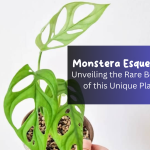Are you a plant enthusiast looking to add a touch of intrigue to your collection? Look no further than the Nepenthes Bloody Mary, a beautiful carnivorous plant that combines beauty and functionality. In this article, we’ll explore the unique characteristics, care requirements, and intriguing nature of the Nepenthes Bloody Mary, making it a must-have addition for plant lovers and collectors alike.
What is Nepenthes Bloody Mary?
Nepenthes Bloody Mary, scientifically known as Nepenthes ventricosa x ampullaria “Bloody Mary,” is a hybrid pitcher plant from Southeast Asia. This mesmerizing carnivorous plant showcases a striking red coloration reminiscent of a glass of its namesake cocktail. The plant results from crossbreeding Nepenthes ventricosa and ampullaria, creating a visually stunning and highly desirable variety.

Unique Characteristics
The Nepenthes Bloody Mary boasts several unique characteristics that set it apart from other carnivorous plants:
- Pitchers: The plant’s most distinctive feature is its vibrant, blood-red pitchers. These elongated, tube-like structures serve as traps for unsuspecting insects. The pitchers contain digestive enzymes that aid in the breakdown and absorption of prey, providing the plant with essential nutrients.
- Leaf Shape: Unlike other Nepenthes hybrids, the Bloody Mary showcases broad, wavy-edged leaves, adding to its visual appeal. The leaves are a lush green with a deep red underside, creating a striking contrast.
- Compact Size: With a compact growth habit, the Bloody Mary is an excellent choice for indoor and outdoor cultivation. It typically reaches a manageable size of around 20-30 centimeters, making it suitable for various spaces and arrangements.
Care Requirements
To ensure the health and vitality of your Nepenthes Bloody Mary, it is crucial to provide the appropriate care. Here are some essential care guidelines to follow:
- Lighting: Place your plant in bright, indirect light. Avoid exposing it to direct sunlight for extended periods, as it can scorch the delicate leaves. A north- or east-facing window with filtered sunlight is ideal if grown indoors.
- Temperature and Humidity: The Bloody Mary thrives in warm and humid conditions, mimicking its natural habitat. Aim for a temperature range of 70-85°F (21-29°C) during the day and slightly cooler temperatures at night. Maintain humidity levels between 50-70% using a humidity tray or placing the plant in a terrarium.
- Watering and Feeding: Keep the soil consistently moist but not soggy. Use distilled or rainwater for watering, as the plant is sensitive to minerals found in tap water. Avoid fertilizing the plant directly, as it gains nutrients from captured prey. However, you can occasionally feed it small insects or fish food to supplement its diet.
- Soil and Potting: Use a well-draining medium specifically formulated for carnivorous plants, such as a mix of sphagnum moss and perlite. Repot the plant when necessary, ensuring the pot has adequate drainage holes to prevent waterlogging.
Fascinating Facts
- Natural Habitat: The Nepenthes Bloody Mary is native to the rainforests of Borneo, where it clings to the sides of cliffs or grows terrestrially in nutrient-poor soil. This unique adaptation allows it to thrive in challenging environments.
- Ecological Importance: Carnivorous plants, including the Bloody Mary, play a vital role in their ecosystems. By capturing insects, they help control pest populations while obtaining necessary nutrients from their prey.
- Hybrid Vigor: As a hybrid plant, the Bloody Mary exhibits hybrid vigor or heterosis, resulting in enhanced characteristics compared to its parent species. This phenomenon contributes to the plant’s robust growth and striking coloration.

Conclusion
The Nepenthes Bloody Mary is a beautiful carnivorous plant, combining its stunning red pitchers, unique leaf shape, and compact size. With proper care and attention, this plant will reward you with its fascinating nature and visual allure. Consider adding the Nepenthes Bloody Mary to your collection to enjoy the beauty and functionality of this unique species. Embark on an exciting journey into the world of carnivorous plants and create a truly enchanting display in your home or garden. Read article about How To Flush Plants Without Overwatering? and The Leggy Pilea in Avi Hoffman Garden.
FAQ
The parents of Nepenthes Bloody Mary are Nepenthes ventricosa and Nepenthes ampullaria. This hybridization created the visually striking Nepenthes Bloody Mary, known for its vibrant red pitchers and unique leaf shape.
Nepenthes Lady Luck is another captivating hybrid variety of the Nepenthes plant. It is a cross between Nepenthes ventricosa and Nepenthes ampullaria. Nepenthes Lady Luck showcases a charming combination of traits from its parent species, including elegant pitchers and attractive foliage. It is highly sought after by plant enthusiasts for its beauty and unique characteristics.
The king of Nepenthes, often considered the largest and most impressive species, is Nepenthes rajah. This species is endemic to the island of Borneo and is renowned for its enormous pitchers, reaching up to 30 centimeters in height. Collectors highly value Nepenthes rajah due to its majestic appearance and status as one of the largest carnivorous plants in the world.
The most endangered Nepenthes species is Nepenthes attenboroughii. Named in honor of the renowned naturalist Sir David Attenborough, this species is native to the Victoria massif in Palawan, Philippines. Nepenthes attenboroughii is critically endangered due to habitat destruction and illegal collection. With a unique pitcher shape and size, it holds a special place in Nepenthes, but its rarity and vulnerability make its conservation of utmost importance. Efforts are being made to protect and preserve this remarkable species from extinction.







